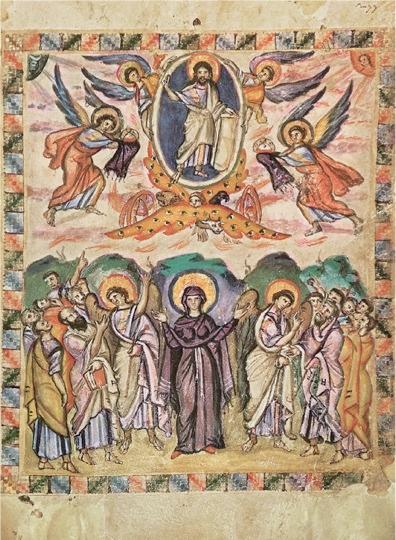Rabbula Gospels, 6th c. Syriac
Mount Calvary Church
Eutaw Street and Madison Avenue
Baltimore, Maryland
A Roman Catholic Parish
The Personal Ordinariate of the Chair of St. Peter
Anglican Use
Rev. Albert Scharbach, Pastor
Dr. Allen Buskirk, Choirmaster
Ascension Thursday
May 30, 2019
7 P. M. Sung Mass
____________________________
Common
Missa super osculetur me, Orlando di Lasso (1532-1594)
Tonight’s service features music in the cori spezzati style pioneered in Venice in the late 16th century: two choirs in different locations pass music back and forth, with the resulting stereophonic effects creating all sorts of dramatic possibilities. Orlando di Lasso, one of the last of the line of Franco-Flemish composers that dominated music in the 16th century, traveled extensively to Italy and worked with the Gabrieli family in Venice who were proponents of the cori spezzati style at San Marco. di Lasso eventually settled in Munich and was one of the most prolific and outstanding composers of the late Renaissance, of the same caliber as Palestrina and Victoria, although his music is not as well known. His Missa super osculetur me is what scholars call a “parody mass” — it is based on his earlier polyphonic motet “Osculetur me” on a text from the Song of Solomon. What is most striking about this mass is the inexhaustible creativity with which Lassus treats the parody technique. Not content simply to quote or extrapolate on motifs from his motet, the composer engages the listener in an elaborate guessing game, sometimes presenting fragments complete (though out of order), as we hear in the Gloria and at other times developing material into longer sections of variation, seen in the Kyrie. The Benedictus departs from the original altogether, offering entirely new material to the listener. Textual interest is sustained through the use of long phrases (with their contrapuntal possibilities) and the different characters offered by single and double choirs.
________________________
Anthems
William Walton (1902-1983)
O be joyful in the Lord, all ye lands: serve the Lord with gladness, and come before his presence with a song. Be ye sure that the Lord he is God; it is he that hath made us, and not we ourselves; we are his people, and the sheep of his pasture. O go your way into his gates with thanksgiving, and into his courts with praise; be thankful unto him, and speak good of his Name. For the Lord is gracious, his mercy is everlasting; and his truth endureth from generation to generation. Glory be to the Father and to the Son and to the Holy Ghost, as it was in the beginning, is now and ever shall be, world without end, Amen.
Hymns
Hail the day that sees Him rise (LLANFAIR) by Charles Wesley (1707-1788) was published in 1739 in Hymns and Sacred Poems under the title “Hymn for Ascension-Day.”
The first and second stanzas employ apostrophe, a rhetorical device in which the poet addresses an absent or inanimate object. The first addresses the day of Jesus’ ascension, the second the gates of heaven which accept Christ in glory. The third emphasizes the true humanity of Jesus and his continued investment in the lives of those on earth, in comparison to his heavenly inheritance described in the previous lines. He is the continuous intercessor for mankind, imploring his assistance in the efforts of all to follow him in the ascent to the presence of God, leading finally to the beatific vision and eternal union with God.
Bread of heaven! on Thee we feed is by Josiah Condor (1789-1855), the son of an engraver and bookseller, and was largely self-educated after leaving school at thirteen. “I am the living bread which came down from heaven . . . Whoso eateth my flesh, and drinketh my blood, hath eternal life. … I am the true vine.”—John vi. 51-4, xv.
See the conqueror mounts in triumph (IN BABILONE) was written Christopher Wordsworth (1807-1885), the nephew of the poet William Wordsworth. Christopher Wordsworth was an athlete, classicist, poet, and Anglican bishop of Lincoln.
The text views the ascending Lord being sung to by angels at heaven’s gates, recalls Christ’s suffering, death, resurrection, and ascension, and looks forward to our reign with Christ in glory. The text emphasizes not only the event of the Ascension but also its meaning for us: in Christ’s ascension, “we by faith can see” our own. Our shared destiny is to be raised with Jesus: “Since we have the same spirit of faith according to what has been written, ‘I believed, and so I spoke,’ we also believe, and so we also speak, knowing that he who raised the Lord Jesus will raise us also with Jesus and bring us with you into his presence.”(2 Cor 4:13-14)
